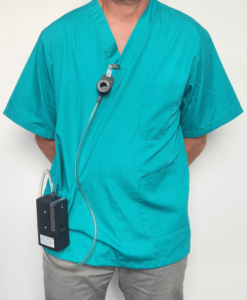Handling formalin spills in operating theatres
Formalin spills in operating theatres can pose a significant risk to staff and patients. That said, formalin is not something that can easily be dispensed with.
This is because it plays an important role in the preservation and optimal handling of tissue samples taken from patients in the operating theatre for histological analysis.
This analysis helps medical teams establish clinical diagnoses for patients, allowing them to make informed decisions for further treatment.
As an accurate diagnosis can only be given where the surgical specimen is handled correctly from the point of collection, formalin plays a crucial role in ensuring this.
What is formalin?
Formalin is a formulation of formaldehyde in aqueous solution. It contains around 40% of formaldehyde, which is a gas in normal conditions.
According to the UK Health Security Agency, inhalation of formaldehyde can cause issues such as sore throat and breathlessness and in severe cases issues such as laryngeal and pulmonary oedema. In addition, skin contact may cause irritation and dermatitis, and it is also irritating to the eyes.
As a result, it is perhaps no surprise that formalin is also hazardous and can cause problems with the eyes, skin and respiratory tract. In addition, as of 1st January 2016, the International Agency for Research on Cancer classified formaldehyde as a class 1 carcinogen.
How to handle a formalin spill
The Control of Substances Hazardous to Health Regulations (COSHH) 2002 requires employers to carry out risk assessments on the use of hazardous substances such as formalin, including putting in place the correct equipment and procedures to handle hazardous incidences.
As formalin spillages are a major health hazard, it is important to have the correct chemical spill kits in place to handle the spill quickly and safely.
Not only will this help to minimise the risk to staff and patients, but it will also minimise disruption that could lead to cancelled procedures and delays in histological analysis.
As formalin is used when transporting specimens, the spill might happen in the operating theatre, laboratory, or between those two locations.
As such, it can be a good idea to have a wall-mounted chemical spill station in both the operating theatres and laboratory, which is in a fixed location that staff are all aware of.
If the chemical spill station needs to be available for areas in close proximity to each other, a chemical spill station in a portable case could be a better solution.
These spills must always be handled by two members of staff who are fully trained in using the chemical spill kits and know how to clear up the spill in the correct way.
Looking for a chemical spill station?
Developed in conjunction with NHS staff, our chemical spill stations for formalin spills come in both a wall-mounted version or a fast-response carrying-case version.
For more information on our chemical spill stations for formalin spills click here.
Or if you need staff training to use the spill kits you can click here for details of our chemical spill management training.
Alternatively, call Cairn Technology’s chemical spill consultants on 0333 015 4345.

 If you manage a fracture clinic plaster room or orthotics laboratory, it is important to ensure that your staff are protected against the risks of inhalable and respirable dust.
If you manage a fracture clinic plaster room or orthotics laboratory, it is important to ensure that your staff are protected against the risks of inhalable and respirable dust. To ensure that this is done, we equip each member of staff with personal sampling pumps and monitor their exposure to dust during a normal working period.
To ensure that this is done, we equip each member of staff with personal sampling pumps and monitor their exposure to dust during a normal working period.